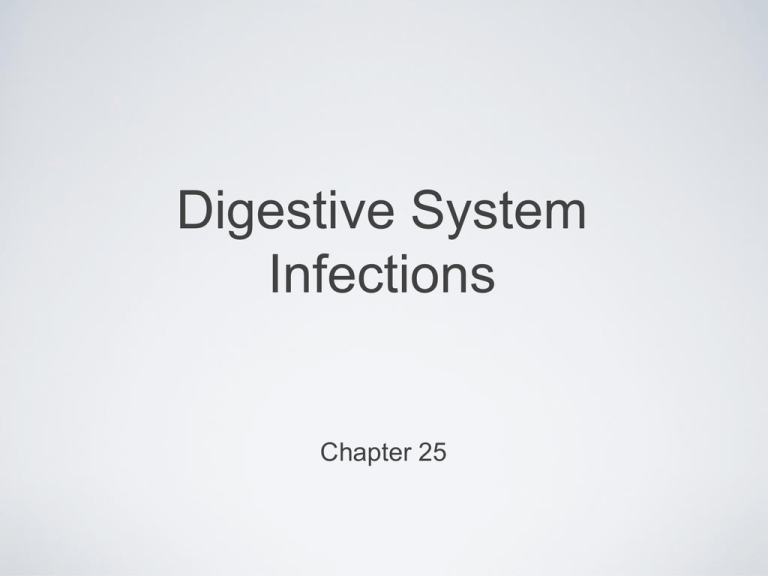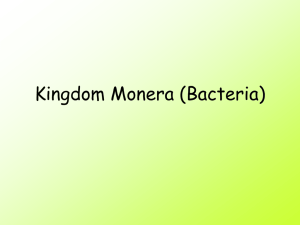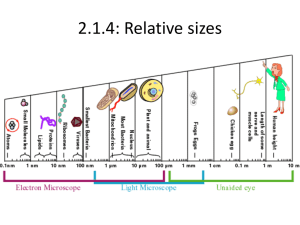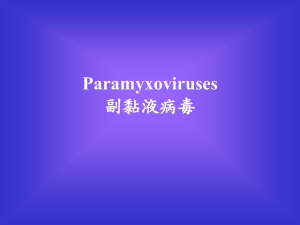chapter25
advertisement

Digestive System Infections Chapter 25 Digestive System Infections • Sometimes referred to as the alimentary or gastrointestinal tract • Passageway running from mouth to anus • One of the body’s boundaries from the environment • Major route of microbial invasion • Main purpose to provide nutrients to body • Divided into upper and lower tracts Normal Flora • Important in protecting body from invasion • Flora of digestive tract mainly found in the oral cavity and intestines – Esophagus has very little flora – Normal stomach is devoid of microorganisms • Killed by stomach acid Normal Flora • Mouth – Relatively few species colonize oral cavity • Streptococcal species most common – Host limits number of bacteria on mucus membranes • Membrane cells constantly shedding – Teeth are nonshedding surface • Large numbers of bacteria can collect and form biofilm – Masses of bacteria termed dental plaque » 100 billion bacteria per gram of plaque Normal Flora • Intestines – Small number of bacteria colonize upper small intestine • Predominant organisms are aerobic and facultative Gram negative bacilli and some streptococci – Large intestine contains very high numbers of organisms • Approximately 1011 bacteria per gram of feces – That is 100 billion bacteria!!!!! • High population is due to abundance of nutrients in feces • Escherichia coli and other enterobacteria predominate bacterial population – Important source of opportunistic infections » Especially of the urinary tract – Normal intestinal flora prevent pathogenic colonization of large intestine Bacterial Disease of the Upper Digestive Tract • Most common human diseases occur in the mouth – Bacterial infections of the stomach are very uncommon • When infections do occur they can lead to ulcers • Oral flora can enter bloodstream during dental procedures – Can cause sub-acute bacterial endocarditis • Chronic gum infections play role in arterial sclerosis and arthritis Dental Caries • Most common infectious disease of human beings – Main reason for tooth loss – As many as 47% of US population over 65 have lost all of their teeth • Symptoms – Usually advanced before symptoms arise – Once symptoms develop they include • Throbbing pain • Noticeable discoloration, roughness, or defect in tooth – Tooth can break while chewing DENTAL CARIES • Causative Agent – Streptococcus mutans most common cause • Colonize teeth – Cannot colonize mouth • Thrive in acidic conditions – Produce lactic acid from sugar metabolism • Produce glucans from sucrose – Glucans essential for production of dental carries •Pathogenesis •Begins with adherence of bacteria to specific receptors on teeth •Production of glucans from dietary sucrose •Glucans bind organisms together and to tooth •Formation of cariogenic plaque •Dietary sugar produces drop in pH •Acidic environment causes calcium phosphate in teeth to dissolve, which creates pits and fissures for colonization Periodontal Disease • Symptoms – Majority of cases asymptomatic – Common symptoms • Bleeding gums • Gum sensitivity • Bad breath • Teeth become loose and discolored • Receding gums • Causative agent – Caused by dental plaque • Plaque forms at area where gum joins the teeth – Numerous bacteria reside in plaque Periodontal Disease • Pathogenesis – Plaque forms on teeth at gum line • Extends into gingival crevice • Bacterial products incite inflammation and immune response – Progression results from enzymes released from organisms that weaken gingival tissue • Causes gingival crevice to widen and deepen – Gram negative organisms increase and release exotoxins • Exotoxins attack host tissue – Membranes and bone softens » Tooth may be lost Helicobacter pylori Gastritis • Symptoms – Range from belching to vomiting – Most are asymptomatic – Symptoms occur when infection is complicated with ulcers or cancer – Symptoms include • Abdominal pain • Tenderness • Bleeding •Causative Agent –Helicobacter pylori •Short •Spiral •Gram negative •Microaerophile •Multiple polar flagella Helicobacter pylori GASTRITIS • Pathogenesis – Bacteria survive extreme acidity of the stomach • Able to neutralize environment –Mucus production decreases •Without mucus stomach lining not protected from acidic environment – Organism uses flagella to corkscrew through –Infection persists for years •Possibly for a life time mucosal lining – Inflammatory response begins Helicobacter pylori GASTRITIS • Epidemiology – Infections tend to cluster in families – Transmission most likely fecal-oral route • Flies also capable of transmission – 20% of US population infected • Incidence increases with age – Almost 80% of those over 75 infected • Rates highest in lower socioeconomic groups •Prevention and Treatment –No proven prevention measures –Infection can usually be eradicated with combined antibiotic treatment •Medication is also used to inhibit production of stomach acid Herpes Simplex • Extremely widespread disease – Many manifestations • Most common form begins in mouth and throat – Infection persists for life – Virus transmissible with saliva – Disease usually insignificant • Disease can be fatal in immunodeficiency HERPES SIMPLEX • Symptoms – Typically begin during childhood – Common symptoms include • Fever and blisters – First lesions which lead to ulcers • Ulcers in mouth and throat – Generally painful – Heal without treatment – After healing disease becomes latent – Symptom recurrence usually begins on the lips • Marked by tingling, itching, burning, or painful sensation •Causative Agent –Herpes simplex virus (HSV) •Medium sized •Enveloped •Double stranded DNA genome •Two types –HSV 1 »Occurs mainly on the lips and mouth –HSV 2 »Responsible for most genital infections Herpes Simplex • Pathogenesis – HSV 1 • Virus multiplies in epithelial cells of mouth or throat • Blisters form – Blisters contain large numbers of mature virions • Some virions carried to lymph vessels and nodes – Immune response produced limits infection • Some virions enter sensory nerves as latent virus – Latent virus can become infectious • Viruses are carried by nerves to skin or mucus membranes – Viruses produce recurrent disease – Stress can precipitate recurrences Herpes Simplex • Epidemiology – Extremely widespread • Infects 90% of some US inner-city populations • Estimated 20% to 40% of Americans suffer from recurrent disease – Transmitted by close physical contact • Virus can survive for several hours on plastic and cloth • Greatest risk of transmission is contact with lesion or infected saliva •Prevention and Treatment –Antivirals such as acyclovir have proved effective in treatment •Prevents DNA replication •Medications do not affect latent viruses • Acute viral illness Mumps – Preferentially attacks salivary and parotid gland – Formerly common in United States • Now rare due to immunization • Causative Agent – Mumps virus • Member of the paramyxovirus family • Enveloped • Single stranded RNA genome MUMPS • Symptoms – Early symptoms • Fever with loss of appetite and headache – Later symptoms • Painful swelling of one or both parotid glands and spasms – Usually makes it difficult to chew and swallow – Symptoms disappear in about a week – Symptoms much more severe in individuals past puberty • Post-pubertal males can suffer painful swelling of testicles • Ovarian involvement occurs in about 20% of cases • Pregnant women often miscarry MUMPS • Pathogenesis – Transmitted by inhalation of infected droplets – Long incubation period • 15 to 20 days – Virus reproduces in the upper respiratory tract • Virus spreads throughout body via bloodstream • Produces symptoms after infecting tissues – In salivary glands • Virus multiplies in epithelium of salivary ducts – Destroys epithelium and releases virus into saliva • Inflammation produced – Inflammation responsible for symptoms and pain • Epidemiology Mumps – Humans only natural host – Natural infection confers lifelong immunity – Virus is spread by asymptomatic individuals in high numbers – Virus can be present in saliva of symptomatic persons • Virus may be present for up to a week before symptoms appear to 2 weeks after • Prevention and Treatment – Prevention directed at immunization • Usually given in same injection as measles and rubella – MMR • Immunization prevents latent recurrent infections – Due to only one viral serotype Cholera • Symptoms – Classic example of severe diarrhea • Can amount to loss of 20 liters of fluid per day – Often termed “rice water stools” due to appearance – Vomiting common in most cases • Usually occurs at the onset of disease – Many suffer muscles cramps • Caused by loss of fluid and electrolytes •Causative Agent –Vibrio cholerae •Gram negative •Curved bacillus •Salt tolerant •Tolerates high alkaline environment CHOLERA • Pathogenesis – Large numbers must be ingested to effect disease due to sensitivity to stomach acid – In small intestine, organisms adhere to epithelial lining and multiply there – Bacteria produced toxin • Cholera toxin – Responsible for symptoms • A-B toxin – B fragment has no toxicity, serves to bind toxin to cells – A fragment responsible for toxicity, causes excess secretion of fluid – Toxin destroyed by heat Cholera Toxin 24 CHOLERA • Epidemiology – Fecal contamination of water most common source of transmission • Crabs and vegetable fertilized with human feces have also been implicated – Person with cholera may discharge at least 1 million bacteria per milliliter of feces CHOLERA • Prevention – Depends largely on • Adequate sanitation • Availability of safe water supplies – Travelers should cook food immediately before eating • Fruit should be peeled personally • Avoid ice unless made with boiled water •Treatment –Treatment depends on rapid replacement of fluids and electrolytes •Essential before irreversible damage to vital organs –Replacement of fluids and electrolytes decreases mortality to less than 1% Shigellosis • Symptoms – Classic symptom is dysentery – Other symptoms include • Headache • Vomiting • Fever stiff neck • Convulsions (rare) • Joint pain – Commonly fatal for infants in developing countries •Causative Agent –Four species of Shigella •S. flexnuri •S. boydii •S. sonnei •S. dysenterriae –All species can cause shigellosis SHIGELLOSIS • Pathogenesis – First step is phagocytosis of bacteria by cells in the large intestine – Cells transport bacteria beneath epithelium – Bacteria adhere to specific receptors near base of epithelial cells – Bacteria multiply at high rate – Shigella bacterium are nonmotile • Move from cell to cell via actin tails – Tails push bacteria from one cell into another – Dead cells slough off • Initiates intense inflammatory response • Areas covered with pus and blood – Responsible for pus and blood in feces SHIGELLOSIS • Pathogenesis – S. dysenteriae • Rarely encountered in United States • Produces potent A-B toxin – Shiga Toxin – Acts much like cholera toxin – Toxin associated with fatal hemolytic uremic SHIGELLOSIS • Epidemiology – Generally has a human source of transmission • Transmitted fecal-oral route – Organism not easily killed by stomach acid • Does not have a high infecting dose – As few as 10 organisms – Transmission occurs most often as a result of overcrowding • Also common in day cares and among homosexual men – Contaminated food and water also responsible for outbreaks SHIGELLOSIS • Prevention and Treatment – Controlled by sanitary measures and surveillance of food handlers and water supplies – No vaccine available – Most important treatment is fluid and electrolyte replacement – Antimicrobials often used to shorten duration of symptoms • Also shorten time bacteria discharged in feces • However 20% of Shigella species are resistant to antibiotics of choice Escherichia coli Gastroenteritis • Symptoms – Depends largely on virulence of infecting strain – Symptoms can range from vomiting and a few loose stools to profuse water diarrhea to severe cramps and bloody diarrhea – Fever not usually prominent – Recovery usually occurs within 10 days •Pathogenesis –Possesses two important virulence factors •Production of enterotoxin •Adherence to cells of small intestine –Virulence factors foster spread Escherichia coli GASTROENTERITIS • Causative Agent – Most diarrhea causing E. coli fall into four groups • Enterotoxigenic E. coli (ETEC) – Most common cause of traveler’s diarrhea • Enteroinvasive E. coli (EIEC) – Disease closely resembles that of Shigella species • Enteropathogenic E. coli (EPEC) – Causes outbreaks in hospital nurseries and bottle fed infants in developing countries • Enterohemorrhagic E. coli (EHEC) – Often produces severe illness due to production of potent group of toxins » Toxins closely related to Shiga toxins – Most common strain O157:H7 Escherichia coli Gastroenteritis • Prevention and Treatment •Epidemiology –Epidemics occur from •Person-to-person spread •Contaminated food and water •Unpasteurized milk and juices –Humans, domestic and wild animals all sources of pathogenic strains – Prevention directed at • Hand washing • Pasteurization of drinks • Proper food preparation – Treatment includes • Replacement of fluids and electrolytes • Infants may require antibiotics – Antibiotics tend to prolong disease in adults – Traveler’s diarrhea can be controlled with bismuth preparations Salmonellosis • Symptoms – Generally characterized by • Diarrhea • Abdominal pain • Nausea • Vomiting • Fever – Symptoms vary depending on virulence of strain and number of infecting organisms – Symptoms are generally short-lived and mild SALMONELLOSIS • Causative Agent – Salmonella species • Motile • Gram negative • Enterobacteria – Salmonella subdivided into over 2,400 serotypes • Salmonella typhimurium and Salmonella enteritidis most common serotypes in United States SALMONELLOSIS • Pathogenesis – Bacteria sensitive to stomach acid • Large number required for infection – Bacteria adhere to receptors on epithelial cells of lower small intestine • Cells take up bacteria through phagocytosis – Bacteria multiply within phagosome discharged through exocytosis – Inflammatory response increases fluid secretion resulting in diarrhea •Pathogenesis –Some strains of Salmonella typhi are not easily eliminated •Organisms cross membrane and resist killing by macrophages –Bacteria multiply within macrophages then carried to bloodstream •Organisms are released when macrophages die and invade tissues –Can result in abscess, septicemia, and shock SALMONELLOSIS • Epidemiology – Bacteria can survive long periods in the environment •Prevention and Treatment –Control depends on reporting cases and tracing source of outbreak – Children are commonly infected –Adequate cooking kills bacterium –Vaccine available for prevention of • Generally by household pets typhoid fever such as turtles, iguanas, and baby chicks – Most cases have an animal source – Enteric fevers, such as those caused by Salmonella typhi are generally the exception – “Typhoid Mary” notorious carrier •Vaccine 50% to 75% effective –Surgical removal of gallbladder eliminates carrier state Norovirus •Responsible for 23 million cases of viral gastroenteritis in United States annually •Originally called Norwalk Virus • Symptoms •Causative Agent – Nausea – Vomiting – Watery diarrhea – Symptoms generally subside in 12 to 60 hours –Norovirus •Small •Nonenveloped •Single stranded RNA genome •Belongs to calicivirus family NOROVIRUS • Pathogenesis – Infects epithelium of upper small intestine – Epithelium generally recovers in approximately 2 weeks – Immunity is not durable • Epidemiology – Transmission via fecal-oral route • Sometimes contracted from eating shellfish – Incubation period 12 to 48 hours – Typically infects children and adults – Infected individuals eliminate virus in feces • Only for a few days Norovirus • Prevention and Treatment – Prevention • Hand washing • Use of disinfectants • No vaccine • No proven antiviral medication Hepatitis A • Symptoms – Fatigue – Fever – Loss of appetite – Nausea – Right side abdominal pain – Dark colored urine and clay colored feces – Jaundice •Symptoms –Children less than 6 years old are generally asymptomatic •Nearly 70% •Jaundice most common –20% of adults require hospitalization –Full recovery in about 2 months –Formally called infectious hepatitis Jaundice 43 HEPATITIS A • Pathogenesis – Transmission from ingestion of contaminated food or water – Ingested virus reaches liver by unknown route • Liver main site of viral replication • Only tissue know to be damaged – Virus is released into bile • Virus laden bile eliminated in feces •Epidemiology –Spreads via fecal-oral route –Many outbreaks originated from restaurants •Due to infected food handler –Raw shellfish frequent source of infection –Low socioeconomic groups make up high percentage of infected –High risk groups include people in day care and nursing homes and homosexual men HEPATITIS A • Causative Agent – Hepatitis A virus (HAV) •Prevention and Treatment –Vaccine available since 1995 – Small •Indicated for travelers to deprived regions, homosexual men, sewer workers, and healthcare workers – Single stranded RNA genome –Gamma globulin contains HAV antibody, can be given to individuals that have been exposed – Belongs to picornavirus family – Given name hepatovirus – Only one serotype • Makes good target for vaccine •Afford short term protection if given within 2 weeks of exposure Hepatitis B •Symptoms –Similar to hepatitis A •Symptoms for hepatitis B more severe –Causes death in 1% to 10% of hospitalized cases –Formerly known as serum hepatitis • Causative Agent – Hepatitis B virus (HBV) • Double stranded DNA genome • Enveloped • Part of the hepadnavirus family • Virus contains 3 important HBV antigens – HBsAg » Surface antigen – HBcAg » Core antigen – HBeAg » e antigen Hepatitis B • Pathogenesis – HBV carried in liver – Mechanism of liver damage unknown • Damage most likely results from immune response – Virus replicates via reverse transcriptase • Viral DNA transported to host nucleus • Host RNA polymerase makes mRNA and RNA copy • RNA copy transcribed by viral reverse transcriptase – New DNA copy is genome for new virus – New viruses bud from host cell Hepatitis B • Epidemiology – Progressive rise in reported cases between 1965 and 1985 • Incidence appears to have plateaued •Epidemiology –Risk factors for infection include •Sharing needles •Tattooing and piercing with contaminated instruments •Shared toothbrushes, razors, and towels – HBV spread mainly by –Sexual intercourse blood, blood products, responsible for nearly 50% of cases in United States and semen – Carriers are of major importance • Often unaware of –Unknown transmission for most of the rest HEPATITIS B • Prevention and Treatment – Vaccine approved in 1980s • New more effective vaccine available since 1986 • Vaccination against HBV can help prevent liver cancer caused by the virus • Childhood immunization – Since addition of the vaccine to routine childhood immunization, incidence of Hep B has declined by nearly 90% – Passive immunization with HBIG (hepatitis B immune globulin) offers immediate protection – No curative treatment Hepatitis C • Symptoms •Causative Agent –Hepatitis C virus – Same as hepatitis A and hepatitis B • Generally milder •Enveloped •Single stranded RNA genome •Member of flavivirus family •West Nile virus •Yellow fever virus • 65% are asymptomatic •Considerable genetic variability –Virus divided into type and subtype • 25% have jaundice Hepatitis C • Pathogenesis – Few details known • No animal model – – – – Infection transmitted via contact with infected blood Incubation period average 6 weeks Over 80% develop chronic infections Virus infects the liver • Incites inflammatory and immune responses – If inflammatory response persists (Th1 cells), infection is resolved – If Treg cells respond, persistent infection ensues – Disease comes and goes • Individuals have times of near normalcy – 10% to 20% will develop cirrhosis or liver cancer HEPATITIS C • Epidemiology – Mechanism of exposure not always obvious – Risk factors include • Sharing toothbrush, razors, towels • Tattooing and piercing with unclean instrument • Sharing syringes – 60% of US cases due to sharing needles – Transmission via intercourse most likely rare • Can occur if multiple partners •Prevention and Treatment –No vaccine for HCV •Only recently has cell culture growth of virus been developed •Vaccination against A and B seem to give some protection –Avoidance of alcohol to limit effect on liver –No satisfactory treatment •Some are helped by interferon therapy –Often has undesirable side effects –Interferon usually combined with ribavirin








